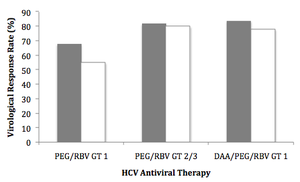Sovaldi and Olysio: Novel Antiviral Treatment for Hepatitis C
Hepatitis C is a viral disease that leads to inflammation of the liver, and is part of the Hepatitis virus family, Flaviviridae, of which A and B are the most well known. Chronic hepatitis C virus (HCV) infection leads to scarring of the liver and cirrhosis, which a significantly heightened chance of liver failure and/or liver cancer. While HCV occurs only in human and chimpanzees, it is a highly transmissible virus that occurs through blood contact often in medical, hard labor intensive, sexual intercourse and intravenous drug use settings. Hepatitis C infections are predominantly treated with a medication cocktail consisting of peginterferon and ribavirin, which have a success rate of 50% but often induces multiple side effects such as flu-like symptoms, anemia and depression [1]. In late 2013, the Federal Drug Administration approved two new non-interferon antiviral drugs to treat Hepatitis C, Gilead's Sovaldi (sofosbuvir) and Johnson and Johnson's Olysio (simeprevir). In test trials involving 197 patients who were not responsive to interferon, the paired administration of Sovaldi and Olysio was shown to clear 90 percent of the Hepatitis C virus [2]. These two novel drugs will be important in the next few years for curing patients with Hepatitis C, especially if costs can be brought down.
Antiviral Treatment for Hepatitis C Virus (HCV)
For an in-depth introduction to the Hepatitis C Virus, please refer to Wilson's MicrobeWiki page on Telaprevir.
Chronic hepatitis B was found to be effectively treated by interferon (IFN) based therapies in the 1960s, and these same drugs were used to treat non-A, non-B (NANB) hepatitis in the mid-1970s [3]. The group of hepatitis viruses causes inflammation of the liver, often leading to cirrhosis and cancer if untreated. Identified in 1989 and renamed from NANB, the hepatitis C virus (HCV) has also been known to infect and cause damage to the digestive system, the lymphatic system, the immune system and the brain [4]. An estimated 150 million people are chronically infected with HCV worldwide, with the blood-borne RNA virus manifesting into six unique, non-interchangeable genotypes across geographies. For 80% of people infected with HCV, the virus is not cleared by the body’s immune system within the first 6 months and chronic infection occurs [4].
In 1986, a National Institutes of Health (NIH) pilot study used recombinant IFN to treat NANB/HCV [3]. A combination of interferon and ribavirin, which was found to lower alanine amino transferase levels but not HCV RNA levels, raised the sustained virological response (SVR) to 42% after 48 weeks (Fig. 2) [5]. When people attain SVR, they remain aviremic for decades after, and so researchers and clinicians use SVR as a marker for curing people of HCV. Long-acting pegylated interferon (PEG) was introduced and prescribed with ribavirin to achieve a 55% SVR rate in the early 2000s, where Genotype 2/3 patients were more responsive to the therapy and their treatment was ended in 24 weeks while Genotype 1 patients required treatment for 48 weeks [6].
Protein inhibitors telaprevir and boceprevir were the first direct-acting antivirals (DAAs) developed; they inhibit the nonstructural 3/4A protease of HCV genotype 1 and are used in combination with PEG and ribavirin in order to prevent resistance mutations [7]. In 2012, the virological response rates hovered around 80% for patients with HCV genotype 1-3 using a combinatown of PEG, ribavirin and/or protein inhibitor DAAs (Fig. 2) [3]. Many HCV drugs are coupled with ribavirin because it is a nucleoside analog that inhibits viral replication [2]. ** The major DAA classes include nucleotide viral NS5B RNA polymerase inhibitors, non-nucleotide viral NS5B RNA polymerase inhibitors, NS3/4a protease inhibitors and NS5A viral replication complex inhibitors and have varying success rates depending on HCV genotype, low barriers to resistance, and result in a wide range of side effects [2]. Interferon also induces multiple side effects including fever/chills, muscle and body aches, headaches, fatigue, depression, anxiety, irratibility, insomnia, mouth ulcers, poor appetite, nausea and vomiting, diarrhea, dehydration, cough, rashes, hair thinning/loss, and reactions at the injection site [8]. As such, researchers sought to develop a non-interferon based HCV antiviral regimen that could be orally-taken, achieve SVR at 12 weeks (short-term), have high barriers to resistance, and tackle multiple HCV genotypes with a special focus on GT 1, which is the most prevalent and the most difficult to treat variant.
With these goals in mind, two new drugs were developed and approved by the FDA in late 2013: sofosburir (Gilead: Sovaldi) and simeprevir (Johnson and Johnson/Janssen: Olysio) [2].
At right is a sample image insertion. It works for any image uploaded anywhere to MicrobeWiki. The insertion code consists of:
Double brackets: [[
Filename: Ebola virus 1.jpeg
Thumbnail status: |thumb|
Pixel size: |300px|
Placement on page: |right|
Legend/credit: Electron micrograph of the Ebola Zaire virus. This was the first photo ever taken of the virus, on 10/13/1976. By Dr. F.A. Murphy, now at U.C. Davis, then at the CDC.
Closed double brackets: ]]
Other examples:
Bold
Italic
Subscript: H2O
Superscript: Fe3+
Overall paper length should be 3,000 words, with at least 3 figures with data.
Sofosburir
Include some current research in each topic, with at least one figure showing data.
Semiprevir
Include some current research in each topic, with at least one figure showing data.
Further Reading
[Sample link] Ebola Hemorrhagic Fever—Centers for Disease Control and Prevention, Special Pathogens Branch
References
Garber, Ken. "Hepatitis C: move over interferon." Nature Biotechnology. 2011. Volume 29. p. 963–966.
[http://bit.ly/1qrk37A Perry, CM. "Telaprevir A Review of its Use in the Management of Genotype 1 Chronic Hepatitis C." Drugs. 2012. Volume 72. p. 619-641.]
[http://ac.els-cdn.com/S0140673601061025/1-s2.0-S0140673601061025-main.pdf?_tid=2625eafa-a8cd-11e3-9ab9-00000aacb361&acdnat=1394508661_be098e28b996fc86cb4644504261f19e Manns, MP., McHutchison, JG., Gordon, SC., Rustgi, VK., Shiffman, M., et al. "Peginterferon alfa-2b plus ribavirin compared with interferon alfa-2b plus ribavirin for initial treatment of chronic hepatitis C: a randomised trial." Lancet. 2001. Volume 358. p. 958-965.]
Edited by Victoria Wong, a student of Nora Sullivan in BIOL168L (Microbiology) in The Keck Science Department of the Claremont Colleges Spring 2014.



